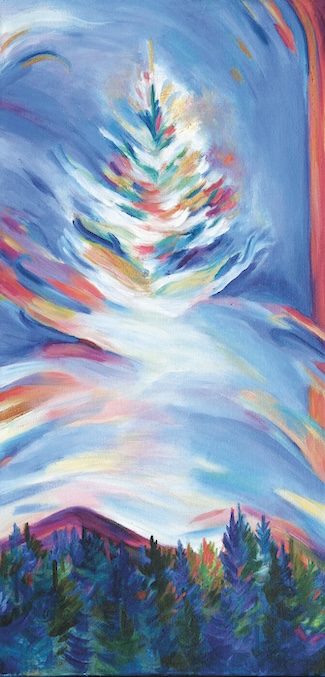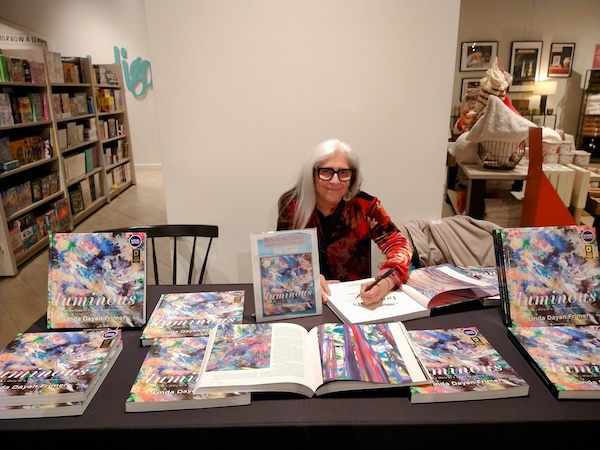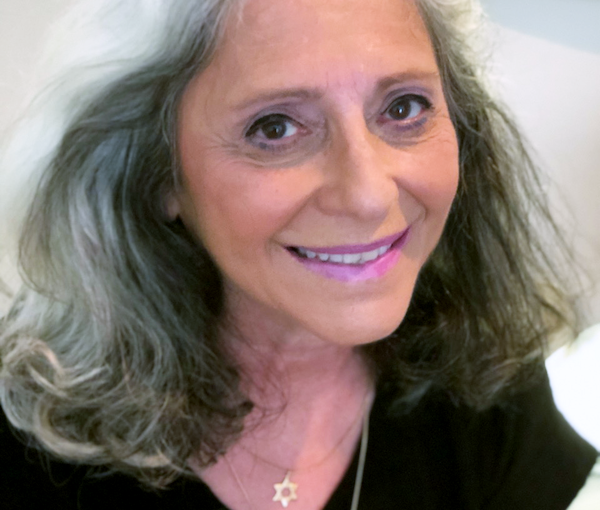Linda Dayan Frimer signs books at the Indigo in Victoria’s Mayfair Mall. (photo by David J. Litvak)
Victoria has always been a magical place for BC artist and author Linda Dayan Frimer. She has exhibited her art at the Empress Hotel and participated in a concert with the Victoria Symphony Orchestra. It was an agent from Victoria who helped kickstart her career and, more recently, she connected with the Victoria editor who worked on her latest book, Luminous. On a trip this fall to Victoria to promote that book, Frimer rekindled her special relationship with British Columbia’s capital.
“Victoria is a place of very special memories and wondrous new happenings for me and my art,” said Frimer.
Recalling her early days, she said, “My large watercolour paintings depicting the landscape of British Columbia, placed in the window of Northern Passage Gallery by the owner and my Victoria-based art agent Valerie Pusey, seemed to fly out the door in swift succession.”
Pusey “was astonishing in helping my art champion many causes,” said Frimer. Those causes included Margaret Laurence House for women leaving an abusive partnership, breast cancer research, and arts and science benefits. With Pusey’s help, Frimer was chosen as the first artist to represent the Trans Canada Trail, with her painting “The Golden Journey, 5000 Miles of Freedom.” That long-ago concert with the Victoria symphony was a fundraiser, with Frimer being invited to paint on stage just behind the orchestra.
“Hearing the symphony inside my heart while painting in harmony with them was an exquisite experience,” Frimer shared.
Frimer’s memoir, Luminous: An Artist’s Story as a Guide to Radical Creativity, follows the history of her ancestors from Romania, Lithuania and Russia, as they experienced cultural turmoil and fled to North America, and delves into the stories of renowned artists and the artworks they produced in response to social injustice and war. The book includes exercises designed to help readers connect with these artists, and to inspire readers to get in touch with their own inner artist and the art of their own story. (See jewishindependent.ca/how-to-be-radically-creative.)

While Frimer has traveled across North America promoting Luminous, this recent trip was her first event in Victoria promoting it. As people passed by the table where Luminous was displayed at Indigo in the Mayfair Mall, they couldn’t help but notice it. One young fan could not take her eyes off it.
“My book was blessed by the appearance of a little 7-year-old girl who appeared at my signing table,” said Frimer. “She began to turn each page of the book intently. After a few minutes, her mother asked her if she would like to go to the toy department. No, she responded, I want to stay right here. She seemed mesmerized by each colour-filled page and, as she pointed out her favourite painting, entitled ‘Wonder,’ I felt a rush of awe. When her mother returned after some time shopping, I gifted the little girl my book and when she received the book, she hugged it tightly. Her mother was in tears and said to us that this was a seminal moment in her daughter’s life that would guide her future.”
Frimer was moved by the encounter.
“This was the best gift my life and art could receive – for I know that each of us is the artist of our own story and, when we are inspired to reach the foundational core of ourselves, we discover true meaning and purpose,” she said. “That afternoon, I realized that, if I had only written my book to bring wonder to this little girl, it had served its purpose.”
In addition to the event at Indigo, Frimer got together with Ellen Godfrey, the editor of Luminous, and Pusey while she was in Victoria.
“I vividly recall my first glimpse of Linda Dayan Frimer’s artwork and my feeling of awe at the interplay of emotion and passion, intelligently expressed through paint on paper,” said Pusey. “That glimpse confirmed all that critics had previously observed: her distinct ability to cultivate colour, light and motion within the watercolour medium. Linda Frimer’s artwork is so fundamentally powerful that it transcends esthetic beauty to express a depth of spiritual awareness and sensitivity. Her message is one of reverence for all of creation.”
During the rest of Frimer’s time in Victoria, seeds were planted for a future event at Congregation Emanu-El and possibly an artist residency at one of the local hotels. For more information about Frimer and her work, visit lindafrimer.ca.
David J. Litvak is a prairie refugee from the North End of Winnipeg who is a freelance writer, former Voice of Peace and Co-op Radio broadcaster, “accidental publicist,” and “accidental mashgiach” at Louis Brier Home and Hospital. His articles have been published in the Forward, Globe and Mail and Seattle Post-Intelligencer. His website is cascadiapublicity.com.


